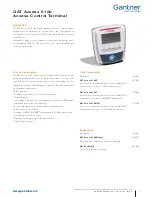
UG-1262
Rev. B | Page 189 of 312
KEYHOLE WRITES
A keyhole write is an indirect write operation wherein user code programs memory mapped registers with a target address and data
values, then commands the flash controller to perform a write operation in the background. The flash controller supports write access to
the flash memory only through keyhole writes. This constraint on write access enables the flash controller to guarantee that writes occur
properly as atomic data word (64-bit) operations with an associated ECC byte, if enabled (see the Protection and Integrity section).
If ECC is enabled, multiple writes to a single data word location cannot be performed without erasing the affected page between writes.
Otherwise, ECC errors are reported. A maximum of two total writes are permitted to a single flash location (data word) between erasures
regardless of ECC or data values, as per the flash intellectual property (IP) specifications. Writing any location more than twice per
erasure can damage the nonvolatile memory or reduce its useful life. If multiple writes per location are required, disable ECC for some
region of flash and target that region for these write operations.
Keyhole operations consist of writes to the following bits:
KH_ADDR, Bits[18:3]. The target address in flash (for example, 0x104). The flash controller automatically trims lower bits to make
the address data word aligned.
KH_DATA0, Bits[31:0]. The bottom 32 bits of the 64-bit data word to be written (for example, 0x76543210).
KH_DATA1, Bits[31:0]. The top 32 bits of the 64-bit data word to be written (for example, 0xFEDCBA98).
CMD, Bits[3:0]. Assert the write command in the flash.
After the write command is asserted, the flash controller initiates a 64-bit dual word write to the address provided in KH_ADDR,
Bits[18:3]. Word (32-bit), half word (16-bit), and byte (8-bit) writes are not supported. Because only 0 is written to the flash, masking can
be used to write individual bits or bytes as necessary, provided the user takes the ECC into account.
Do not write to any of the keyhole registers when DMA access is enabled (UCFG, Bit 0 is set). Writing to these registers manually while
DMA is enabled may result in spurious flash writes and can put the DMA and flash controllers out of synchronization, potentially
stalling the DMA controller for long periods of time (approximately 20 μs to 40 μs).
BURST WRITES
Each 2 kB page of flash memory consists of eight rows of 256 bytes. Design constraints for programming the flash IP enable back to back
writes within a single row to complete more quickly than the equivalent writes across row boundaries. For optimizing writes, attempt to
write flash memory in aligned blocks of up to 256 bytes. For example, Row 0 is from flash offset Address 0x00 to Address 0xFC.
Similarly, Row 1023 is from 0x3FF00 to 0x3FFFFC.
To benefit from this write performance gain, the second and subsequent 64-bit write must be requested before the flash controller
completes the first write. The STAT, Bit 3 flag is set when the first 64-bit write operation is nearing completion. This setting provides
user code with a manageable window of time in which to assert the next write request. This flag can be polled or an interrupt can optionally be
generated when it is asserted. Further descriptions of STAT, Bit 3 (WRALCOMP) and other available status flags are in Table 221.
Table 221. Status Flags
Flag Name
Description
CMDBUSY
Command busy. High when the controller is processing a command from the CMD register.
WRCLOSE
Keyhole closed. High during the first half of a write command, cleared when keyhole registers are free to be
programmed for a subsequent write command.
CMDCOMP
Command complete. Sticky flag, set when a command is completed. Write 1 to clear.
WRALCOMP
Write almost completed. Sticky flag, set when approximately 20 μs to 40 μs remains for an ongoing write
command. Write 1 to clear.
The following list outlines the procedure for performing multiple writes with the potential to burst within a row:
1.
Wait for the STAT bit, CMDBUSY flag, to clear to ensure the prior command is ongoing.
2.
Disable all interrupts so that sequenced writes to the KH_ADDR register, KH_DATA0 register, KH_DATA1 register, and CMD
register are not interrupted by an interrupt service routine (ISR), which may also have flash writes.
3.
Request the first 64-bit write through the keyhole access.
4.
The flash controller starts the write process after the write command is written to the CMD register.
5.
Check if the write command was accepted by reading the STAT register to see if any error flags are set. If the command results in an
error, the write is not be performed.
6.
Set IEN, Bit 1 to enable interrupt generation when WRALCOMP is asserted, and reenable other interrupts.
7.
Continue the user program. The WRALCOMP interrupt vectors to an interrupt service routine to request the next write at the
appropriate time.
















































